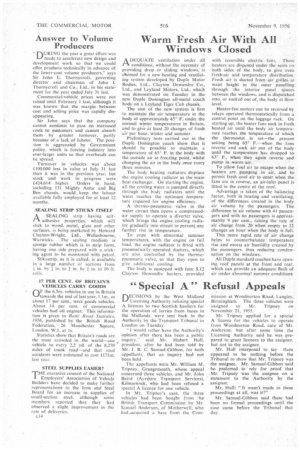Answer to Volume Producers
Page 52

If you've noticed an error in this article please click here to report it so we can fix it.
"nuR1NCi the year a great effort was
made to accelerate new design and development work so that we could offer products technically in advance of the lower-cost volume producers," says Sir John E. Thornycroft, governing director and chairman of John I. Thornycroft and Co., Ltd., in his state: merit for the year ended July 34 last.
Commercial-vehicle prices were not raised until February I last, although it was known that the margin between cost and selling price was rapidly disappearing.
Sir John says that the company cannot continue to pass on increased costs to eustomers and cannot absorb them by greater turnover, partly because of a lack of labour. The position is aggravated by Government policy, which is forcing industry into ever-larger units so that overheads can he spread.
Turnover in _vehicles was about £100.000 less in value at July 31 last than it was in the previous year, but stock and work in progress were 4:424.614 higher. Orders in hand, including 131 Mighty Antar and Big Ben chassis, would keep the labour available fully employed for at least 12 months.
SEALING STRIP STICKS ITSELF
A SEALING strip having selfr "V adhesive properties, which will stick to wood, metal, glass and other surfaces, is being marketed by Howard Clayton-Wright, Ltd., Wellesbourne, Warwicks. The sealing medium is sponge rubber which is in strip form, having one side prepared with a sticking agent to he moistened with petrol. Stikastrip. as it is called, is available in a large number of sections from in. by .1 in. to in. by I. in. in 10 ft. rolls.
17 PER CENT. OF BRITAIN'S VEHICLES CARRY GOODS
OF the 6.5m. vehicles in use in Britain towards the end of last year, 1.1m., or about 17 per cent., were goods vehicles. About 14 per cent. of commercial vehicles had oil engines. This information is given in Basle Road Statistics, 1956, published by the British Road Federation, 26 Manchester Square. London, W.1, at Is.
Statistics show that Britain's roads are the most crowded in the world—one vehicle to every 2.2 yd. of the 8,270 miles of trunk road—and that road accidents were estimated to cost £171m. last year.
STEEL SUPPLIES EASIER? THE executive council of the National I Employers' Association of Vehicle Builders have decided to make further representations to the Iron and Steel Board for an increase in supplies of small-section steel, although some members reported that they had observed a slight improvement in the rate of deliveries.
cl 4




























































































































